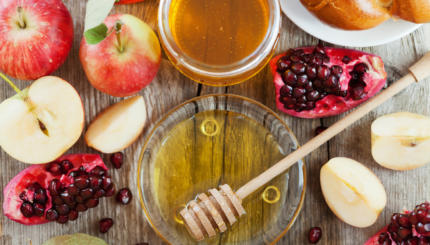Originally a day to calculate taxes on produce, the kabbalists (mystics) of Safed in the Land of Israel in the 16th century created a new ritual to celebrate Tu Bishvat. Modelled on the Passover seder (though less complex) the Tu Bishvat seder is a time to appreciate the fruits from God, drink wine and discuss mystical connotations of the holiday.
The traditional Tu B’Shvat seder has a loose structure and leaves a lot of room for creativity. If you’re planning a larger event, you’ll want to pack it with interesting programming that invites guest participation and consider using breakout rooms to create opportunities for more personal interaction. If you’re planning a small seder for close friends or family, you can keep it more open-ended.
Know the Structure of the Seder
As at Passover, participants in a Tu Bishvat seder traditionally drink four cups of wine. The kabbalists mixed wines in various shades of red and white to symbolize the various sefirot, the mystical dimensions that are an essential part of Kabbalistic teachings. Some of the themes represented in the Tu Bishvat seder are atzilut, God’s emanating energy, the transience of the passing seasons, beriah, or creation, and the spark of God within each person.
As Tu Bishvat is a celebration of trees, it is also traditional to eat fruits including those that are hard on the outside and soft on the inside, those with a pit, fruits that are completely edible, and fruit that has a tough skin on the outside but is sweet on the inside. Each kind of fruit symbolizes something different from protection, to nourishing the body, to the mystery of God’s omnipotence to the power of the Torah’s secrets. Learn more about the meaning and symbolism behind the wine and fruits here.

Help us keep Jewish knowledge accessible to millions of people around the world.
Your donation to My Jewish Learning fuels endless journeys of Jewish discovery. With your help, My Jewish Learning can continue to provide nonstop opportunities for learning, connection and growth.
Gather the Goods
If you are having a small seder, you can send fruit and wine packages to your friends who are joining, or you can simply ask them to kindly purchase a few of the fruits that you are looking to eat for the purposes of the seder. If you are mailing packages, consider sending packages with an item that visually unites everyone on their screen, such as a flower crown, or a thematically-appropriate t-shirt. Having something everyone wears during the event helps create a sense of community and afterward, provides your guests with a cute memento!
Each guest will need a bottle of red and white wine, and one fruit option for each of the four fruits. Here’s a quick suggested shopping to get you started:
First fruit: walnuts, coconuts or almonds
Second fruit: olives or dates (or peaches, apricots, etc.)
Third fruit: figs, grapes, and raisins
Fourth fruit: mangos, bananas, avocados, or sabra (desert pear)
Choose a Haggadah or Make Your Own!
Different haggadahs will help you create different seders — there are many out there! Here is a list of some of the Tu Bishvat haggadahs available online. You can ask your guests to either open or print whichever haggadah you choose for the seder.
Have Fun With It!
Everyone is seeking connection with others during this difficult time. A Tu Bishvat zoom seder invites friends together to come together and look away from the chaos of the world and into the mystical insights from the mystical teachings of the Torah. Think about what aspects of the holiday — its environmental dimension? its mystical dimension? noshing fruit? — interests your guests and what interests you and find a way to incorporate it into your seder. Add a painting section for your art lovers, subtract a cup or two of wine (four is quite a lot — some seders opt for juice instead!) or make a Tu Bishvat trivia game to educate any little ones that might join the festivities. The event is only limited by your imagination.
Chag Sameach!


